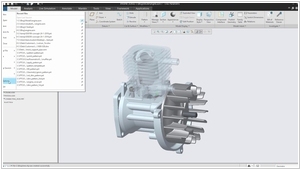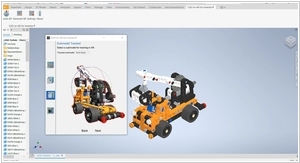Autodesk Inventor vs Creo
September 21, 2023 | Author: Michael Stromann
11

Creo is the 3D CAD solution that helps you accelerate product innovation to build better products faster. Easy to learn, Creo uses a model-based approach to seamlessly take you from the earliest phases of product design to manufacturing, and beyond. Available both on-premises and as a SaaS product.
Autodesk Inventor and PTC Creo (formerly known as Pro/ENGINEER) are both industry-leading CAD (Computer-Aided Design) software solutions, but they have distinct differences that cater to different user preferences and design requirements.
One significant difference between Autodesk Inventor and Creo is their approach to parametric modeling. Inventor, developed by Autodesk, offers a more user-friendly and intuitive interface for parametric modeling. It's often favored by designers who prioritize ease of use and quick learning curves. In contrast, Creo, developed by PTC, provides a more robust and comprehensive parametric modeling environment, making it a preferred choice for complex and highly detailed designs. Creo's parametric capabilities are known for their flexibility and precision, which can be advantageous for industries like aerospace and automotive where intricate design control is critical.
Another notable distinction lies in their ecosystems and integrations. Autodesk offers a wide range of design and engineering software products, creating a cohesive ecosystem that allows seamless data transfer between tools like AutoCAD and Fusion 360. This can be beneficial for users who need a variety of design and engineering capabilities. Creo, on the other hand, focuses primarily on CAD and product lifecycle management (PLM) solutions, making it a more specialized tool for companies seeking comprehensive product development and lifecycle management but may require additional software for tasks like architectural design.
See also: Top 10 CAD software
One significant difference between Autodesk Inventor and Creo is their approach to parametric modeling. Inventor, developed by Autodesk, offers a more user-friendly and intuitive interface for parametric modeling. It's often favored by designers who prioritize ease of use and quick learning curves. In contrast, Creo, developed by PTC, provides a more robust and comprehensive parametric modeling environment, making it a preferred choice for complex and highly detailed designs. Creo's parametric capabilities are known for their flexibility and precision, which can be advantageous for industries like aerospace and automotive where intricate design control is critical.
Another notable distinction lies in their ecosystems and integrations. Autodesk offers a wide range of design and engineering software products, creating a cohesive ecosystem that allows seamless data transfer between tools like AutoCAD and Fusion 360. This can be beneficial for users who need a variety of design and engineering capabilities. Creo, on the other hand, focuses primarily on CAD and product lifecycle management (PLM) solutions, making it a more specialized tool for companies seeking comprehensive product development and lifecycle management but may require additional software for tasks like architectural design.
See also: Top 10 CAD software



